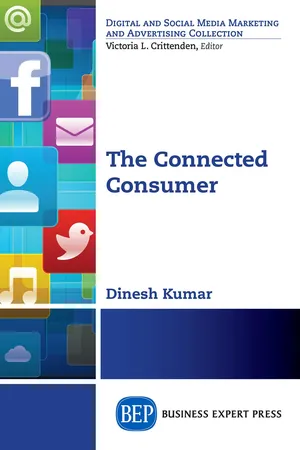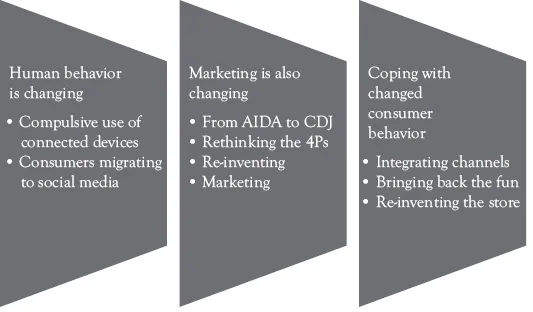
This is a test
- 172 pages
- English
- ePUB (mobile friendly)
- Available on iOS & Android
eBook - ePub
The Connected Consumer
Book details
Book preview
Table of contents
Citations
About This Book
Traditional marketing faces challenges as never before. The way that people interact with each other and with companies is changing completely in todayÕs era of 24/7 connectivity. This book explores tectonic changes in buyer behavior and how businesses are responding to those changes. It describes how data is used to track and analyze customers in almost everything they do, and how marketing communications are delivered with precision to individual mobile devices. The connected customer is blurring the line between online and offline sales resulting in an entirely new purchase cycle.
Frequently asked questions
At the moment all of our mobile-responsive ePub books are available to download via the app. Most of our PDFs are also available to download and we're working on making the final remaining ones downloadable now. Learn more here.
Both plans give you full access to the library and all of Perlego’s features. The only differences are the price and subscription period: With the annual plan you’ll save around 30% compared to 12 months on the monthly plan.
We are an online textbook subscription service, where you can get access to an entire online library for less than the price of a single book per month. With over 1 million books across 1000+ topics, we’ve got you covered! Learn more here.
Look out for the read-aloud symbol on your next book to see if you can listen to it. The read-aloud tool reads text aloud for you, highlighting the text as it is being read. You can pause it, speed it up and slow it down. Learn more here.
Yes, you can access The Connected Consumer by Dinesh Kumar in PDF and/or ePUB format, as well as other popular books in Betriebswirtschaft & Werbung. We have over one million books available in our catalogue for you to explore.
Information
Topic
BetriebswirtschaftSubtopic
WerbungCHAPTER 1
Traditional Marketing Faces a Challenge Today
Mary is a bright young girl born at the turn of the century, who loves her phone. She uses it for a number of things and checks it every few minutes. It is an addiction. Young people like Mary can’t do without 24/7 connectivity and their behavior is changing because of that. Consequently, how they search and buy things is changing too. The traditional marketing model no longer works and businesses have to change in response to tectonic changes in human behavior. Companies have to cater to a growing population of connected consumers like Mary, and we follow her in this book, discovering the huge changes that she and people like her are causing. In this chapter, we look at changes in the way that companies will do business.
There was a time, not very long ago, when companies relied on similar marketing methods to get their idea across to consumers. Newspapers and television carried ads into people’s homes. The daily dose of entertainment and news also slipped in advertisements that showed beautiful people using those products and living happily ever after. Then the companies waited as people rushed to stores to buy their soaps and lotions and the great things that had made the people so wonderful and happy.
Marketing consisted of periodically spraying consumers with advertising in the manner of using sprays on insects: The spray and pray strategy worked for a while, after which the little things got immune and newer sprays had to be invented. Consumers similarly got immune after a while and then newer ways of persuading them had to be found.
The advertising sprays worked for many years, riding on the power of mass media. But then, the media started fragmenting. Channels and newspapers multiplied. Marketing managers did not know who was watching what. The invention of the remote control further spoiled the traditional model: It gave consumers the power to zap advertisements. Companies were losing the means to reach their customers.
This was not all.
The IT industry then reduced the size of computers and placed them on people’s laps. People could now choose what they wanted to watch and when, rather than depend on TV channels or newspapers. Mobile phones further put small screens in the hands of people which they could carry wherever they went. Consumers no longer relied on mass media now, but could watch or read anything, anywhere. The marriage of mobiles and IT gave more power to consumers—they could do much more now—connect with friends, post comments and reviews, engage with brands, or tell them off, even while doing many other things (Exhibit 1.1).
Exhibit 1.1
A Day in Mary’s Life
Mary wakes up, gets ready for work, and hurries to the subway station. At the gates, she swipes her watch at the turnstile, which reads the code on it and the gates open for her. In the train, she remembers she has to buy groceries, she needs a new dress, and a beep on the phone tells her that the birthday of a friend is approaching. She settles down on her seat and uses her phone to place an order for groceries on a site she trusts. It already has a shopping list based on her past purchases and all she has to do is tick whatever she needs. Payment is made seamlessly by pressing her thumb print on the screen.
Next she decides to look for a dress and browses several of them. When she gets down from the train, she grabs a coffee from a kiosk and pays by swiping her watch. A screen at the kiosk displays dresses similar to the one she is searching. One of them catches her eye and she takes a picture of the Quick Response (QR) code on her phone.
At work, she is busy in the morning; but when she is free, she tries the dresses she had browsed earlier on a virtual model that looks like her. When she shortlists some, she sends it to her friends for their opinions. Her friends immediately respond with their comments and also send her links to reviews that others have posted.
After office, she goes to her favorite store to try out some dresses. The store manager greets her by name and shows her dresses on 3-D displays and virtual models. Her friend, who has tracked her through an app, walks in and the two girls look and select a dress.
Unfortunately, the dress that she selects is not available in her size. The store manager uses his tablet to see if it is available in another store. An order is placed.
By the time she gets home, her groceries have been delivered. Soon a drone arrives with her dress and she excitedly tries it on.
Tectonic Changes
This represents a tectonic change in human behavior as never before. Consequently, companies have had to make changes in the way they make marketing plans because the traditional ways of communicating with and engaging people have changed (Figure 1.1). The smartphone has changed the way we go about our lives in many ways as follows:

Figure 1.1 Changes in human behavior are forcing marketing to change, which in turn is inducing change in the ways of doing business
- People access information about anything, anytime.
- They post pictures and videos about themselves and what they experience.
- People connect with their friends, strangers, and companies at the click of a button.
- Things are bought and sold with ease, and a sharing economy is also taking shape.
- Apps allow people to do a variety of things on the devices.
Frelin (2013) writes, “Digital has resulted in profound shifts in the business of marketing, with innovation dramatically increasing the ability to target and engage with consumers.” Apps allow customers and companies to interact with each other in progressively better ways.
People are giving mass media the go-by and are instead perpetually using their mobile devices or checking them: It has become an addiction. A report by Flurry Analytics says that an average mobile user launches an app 10 times per day, but a mobile addict launches them more than 60 times each day. By tracking 500,000 apps on 1.3 billion mobile devices, Flurry has deduced that the number of mobile addicts grew from 79 million peopl...
Table of contents
- Cover
- Title
- Copyright
- Abstract
- Contents
- Acknowledgments
- Chapter 1: Traditional Marketing Faces a Challenge Today
- Chapter 2: The Age of E-commerce
- Chapter 3: The Connected Customer
- Chapter 4: The Connected Company
- Chapter 5: Data Mining and Analytics
- Chapter 6: Marketing Communications for the Connected Consumer
- Chapter 7: Measuring Web Equity
- Chapter 8: Future of Consumer Behavior
- References
- Index
- AdPage
- Backcover